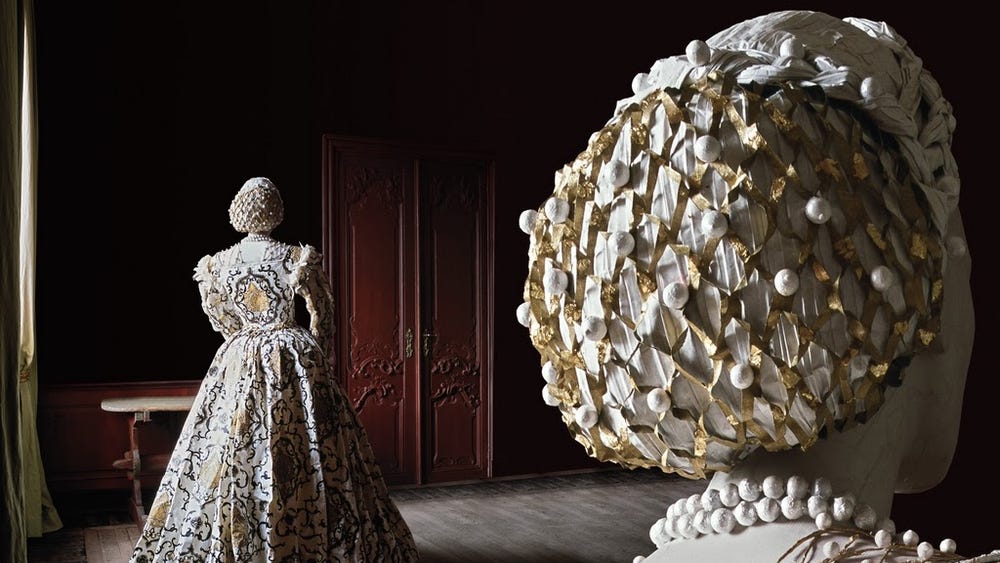Pulp Fashion: The Art of Isabelle de Borchgrave at the Legion of Honor
Oct 8, 2010
Eleanor of Toledo (and detail), 2006
San Francisco, October 2010—For more than fifteen years, the Belgian artist Isabelle de Borchgrave has been producing a completely original body of work that is quite easy to explain but very difficult to categorize. Her central project has been to recreate exquisite, life-size historical costumes entirely from paper. Taking inspiration from the rich depictions in early European paintings, iconic costumes in museum collections, photographs, sketches and even literary descriptions, de Borchgrave skillfully works paper to achieve the effect of textiles: crumpling, pleating, braiding, feathering and painting the surface. The artist’s exhibition Pulp Fashion: The Art of Isabelle de Borchgrave is on view February 5 to June 5, 2011, at the Legion of Honor as part of the Collection Connections series. Fine Arts Museums director John E. Buchanan, Jr., says of the exhibition, “I am proud to say that this exhibition, so appropriately presented in the galleries of our Legion of Honor museum, is the first to offer an overview of the artist’s most important bodies of work: from the white dresses and Papiers à la Mode to the Fortuny and Medici collections and her newest creations.”
Exhibition
The Legion’s presentation of over 60 trompe l’oeil masterpieces draws on several themes presenting quintessential examples in the history of costume—from Renaissance costumes of the Medici family and gowns worn by Elizabeth I and Marie-Antoinette to the designs of the grand couturiers Fredrick Worth, Paul Poiret, Christian Dior and Coco Chanel. Special attention is given to the creations and studio of Mariano Fortuny, the eccentric early 20th-century artist, who is both a kindred spirit and a major source of inspiration to de Borchgrave. Additionally, five creations inspired by four paintings in the Legion of Honor’s European collection will be presented for the very first time.
The exhibition is presented in six sections:
- The Artist’s Studio is recreated to provide insight into de Borchgrave’s creative process.
- In White showcases the purity of craftsmanship in a selection of nine dresses devoid of color.
- Papiers à la Mode features iconic looks from key periods in fashion history created in collaboration with costume historian Rita Brown; gowns worn by such legendary historical figures as Elizabeth I, Madame de Pompadour, Empress Eugénie and Marie-Antoinette. Famous designers such as Charles Fredrick Worth, Paul Poiret and Coco Chanel are represented by signature pieces.
- Fortuny is an immersive environment created under a feather-light paper tent populated by recreations of Fortuny’s famed pleated and draped gowns.
- The Medici is the artist’s most extravagant series, with elaborate velvets, needlework lace, ropes of pearls, and intricate coiffures transformed into paper sculpture.
- Inspiration—During a visit the Legion of Honor in the summer of 2010, the artist selected four paintings from the museum’s European painting collection as the inspiration for her latest body of work. The paintings are: Massimo Stanzione, Woman in Neapolitan Costume, ca. 1635, Konstantin Makovsky, The Russian Bride’s Attire, 1889, Jacob-Ferdinand Voet, Anna Caffarelli Minuttiba, ca. 1675, and Anthony van Dyck, Marie Claire de Cory and Child, 1634.
Artist
Isabelle de Borchgrave is a painter by training, but textiles and costumes are her muses. Working in collaboration with leading costume historians and young fashion designers, de Borchgrave creates a world of splendor from simplest rag paper. Painting and manipulating the paper, she crafts elaborate dresses inspired by the rich depictions in early European painting or by the iconic costumes in museum collections around the world. In her work, she explores the minds of the artists who created or depicted the gowns and imagines the psyche of the women who wore them, transporting her audience to another time and place.
Though de Borchgrave’s knowledge of textile traditions is encyclopedic, she does not literally duplicate patterns. Instead she masterfully works the paper to a desired effect. With her trompe l’oeil gowns, she invites her viewers to explore her imaginary world and to create their own illusions. As de Borchgrave explains, “Although my inspiration springs from the period dresses in the great museum collections, this is just a wink at history. My work is a confluence of influences—paper, painting, sculptor, textiles, costume, illusion and trompe l’oeil.”
Catalogue
The exhibition catalogue explores the exquisite paper costumes of the Belgian artist Isabelle de Borchgrave. Author Jill D’Alessandro contextualizes de Borchgrave’s work against the rich tapestry of art and couture history, examining how the artist brings long-lost fashions to life through an intricate process of tailoring, crumpling, braiding, pleating and painting paper. Luxurious reproductions of de Borchgrave’s astonishing trompe-l’oeil effects offer an intimate encounter with the work, from the austere white dresses and Papiers à la Mode to the lavish Fortuny and Medici collections. A special section focuses on the making of a new work inspired by a seventeenth-century Italian portrait in the collection of the Fine Arts Museums of San Francisco. The catalogue is available in the special exhibition Museum Store (hardback 104 pages, $29.95).
Collection Connections
Collection Connections is a series that presents new works that aim to reinterpret traditional objects from the Fine Arts Museums’ permanent collections. The contemporary artists create installations that transform the conventional experience of museum visitors. For each project, artist and curator draw inspiration from the permanent collection, offering nontraditional connections that provide visual and educational opportunities to explain, interpret, and recontextualize the art objects on display throughout the museum. Through these projects, visitors are given a window into the ways that artists and cultural institutions construct and disseminate knowledge about historical understanding and current attitudes.
Organization
Pulp Fashion: The Art of Isabelle de Borchgrave is organized by the Fine Arts Museums of San Francisco and sponsored by Lonna Wais. Additional support is provided by Elizabeth W. Vobach. Collection Connections is made possible by The Annenberg Foundation. The exhibition catalogue is supported in part by a grant from Friends of Fiber Art International.
